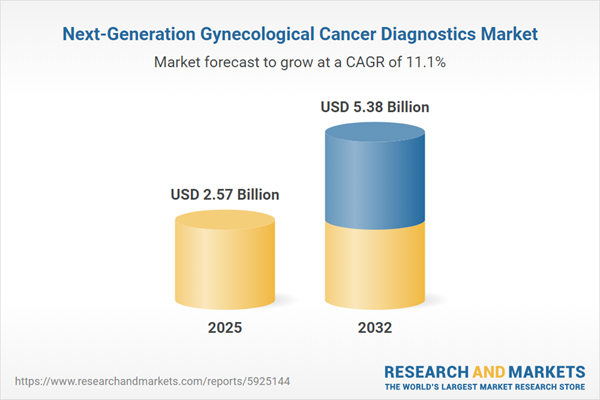Speak directly to the analyst to clarify any post sales queries you may have.
The next-generation gynecological cancer diagnostics market is redefining clinical and operational practices in women’s health, driving measurable improvements for executive leaders seeking to optimize diagnostic precision, workflow efficiency, and patient outcomes.
Market Snapshot: Next-Generation Gynecological Cancer Diagnostics Market Size and Outlook
In 2024, the global next-generation gynecological cancer diagnostics market is valued at USD 2.32 billion, with robust growth anticipated to reach USD 2.57 billion by 2025 and USD 5.38 billion by 2032. This pace represents an estimated 11.07% compound annual growth rate. Strategic adoption of precision diagnostics, rapid advancements in molecular testing solutions, and rising use of personalized medicine are elevating standards across clinical care systems. Healthcare networks are moving toward interoperable automation and early detection tools, with evolving care models emerging across major regions and provider groups.
Scope & Segmentation: Strategic Drivers and Core Market Segments
- Technologies: Incorporation of advanced biomarker assays, polymerase chain reaction, molecular diagnostics, next-generation sequencing, and immunoassays supports reliable marker detection and streamlined analysis for healthcare teams.
- Biomarker Types: Epigenetic, genetic, and protein biomarkers facilitate tailored diagnostics, enabling responsive solutions suited for heterogeneous patient populations.
- Applications: Diagnostic innovations for cervical, endometrial, ovarian, and vulvar cancers address distinct clinical complexities and enable scenario-specific disease assessment.
- Products: A full array of assay kits, analytical instruments, diagnostic reagents, and integrated software platforms uphold comprehensive workflows and secure data management. Emphasis on system interoperability allows seamless connectivity within laboratory and information technology environments.
- End Users: Diagnostic laboratories, hospitals, academic research bodies, and point-of-care centers utilize scalable solutions that span a wide spectrum of operational requirements.
- Distribution Channels: Direct sales, distributor networks, and online procurement methods offer procurement flexibility, catering to different organizational purchasing protocols in centralized and decentralized healthcare models.
- Regions Profiled: The Americas, Europe, Middle East, Africa, and Asia-Pacific comprise the principal regional markets. Each area demonstrates distinct procurement standards and infrastructure dynamics, particularly in countries such as the United States, Germany, China, and India.
- Leading Companies: F. Hoffmann-La Roche Ltd, Hologic, Inc., QIAGEN N.V., Abbott Laboratories, and Thermo Fisher Scientific Inc. guide innovation, supporting evolving adoption patterns with established diagnostic platforms.
Key Takeaways for Senior Decision-Makers
- Molecular profiling combined with artificial intelligence streamlines pathology operations and supports prompt, evidence-based decision-making, benefiting facilities managing large volumes.
- Extensive biomarker panels enable clinicians to pinpoint cancer subtypes, improving the accuracy of therapy selection and comprehensive care planning.
- Expansion of access to cloud-enabled and point-of-care diagnostics extends advanced testing capabilities to underserved regions, improving both service reach and operational resilience.
- Investment in local and regional supply chains strengthens preparedness for fluctuations in supply conditions, regulatory developments, and external disruptions.
- Cross-sector collaboration between diagnostic solution providers, research stakeholders, and technology innovators expedites the introduction of new testing options and ensures close regulatory cooperation.
- Ongoing adaptation to emerging reimbursement structures and policy updates maintains compliance and facilitates agile regulatory risk management.
Tariff Impact and Global Trade Shifts
Upcoming changes to U.S. tariffs for 2025 are prompting diagnostic suppliers and healthcare organizations in the next-generation gynecological cancer diagnostics market to reevaluate sourcing practices. Adjustments in procurement strategies and expansion of regional supply chains are enhancing cost control and risk management, providing a greater degree of operational stability amid evolving global trade conditions. Strategic planning is central to achieving sustained market continuity.
Methodology & Data Sources
Findings are based on direct interviews with oncology clinicians, laboratory leaders, and regulatory experts. A comprehensive literature review, paired with rigorous data triangulation, assures that analyses support strategic business decisions.
Why This Report Matters
- Delivers targeted market intelligence to guide executive strategy in procurement, capital allocation, and digital transformation under shifting regulatory mandates.
- Enables organizations to design supply chains that are responsive and resilient, addressing operational challenges in dynamic regional and global environments.
- Provides strategic insights for adopting new diagnostic platforms and improving laboratory processes, supporting consistent service quality and process optimization.
Conclusion
With these strategic insights, senior leaders are equipped to anticipate sector evolution, steer technology adoption, and maintain strong standards in gynecological cancer diagnostics, ensuring organizational agility and resilience in a rapidly changing market.
Additional Product Information:
- Purchase of this report includes 1 year online access with quarterly updates.
- This report can be updated on request. Please contact our Customer Experience team using the Ask a Question widget on our website.
Table of Contents
3. Executive Summary
4. Market Overview
7. Cumulative Impact of Artificial Intelligence 2025
Companies Mentioned
The companies profiled in this Next-Generation Gynecological Cancer Diagnostics market report include:- F. Hoffmann-La Roche Ltd
- Hologic, Inc.
- QIAGEN N.V.
- Abbott Laboratories
- Thermo Fisher Scientific Inc.
- Becton, Dickinson and Company
- Danaher Corporation
- Illumina, Inc.
- Myriad Genetics, Inc.
- Agilent Technologies, Inc.
Table Information
| Report Attribute | Details |
|---|---|
| No. of Pages | 187 |
| Published | November 2025 |
| Forecast Period | 2025 - 2032 |
| Estimated Market Value ( USD | $ 2.57 Billion |
| Forecasted Market Value ( USD | $ 5.38 Billion |
| Compound Annual Growth Rate | 11.0% |
| Regions Covered | Global |
| No. of Companies Mentioned | 10 |









